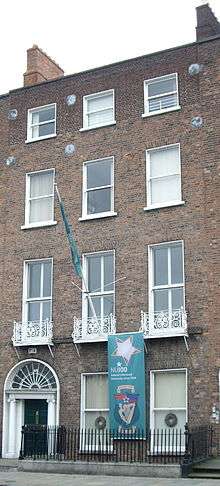National University of Ireland
The National University of Ireland (NUI) (Irish: Ollscoil na hÉireann) is a federal university system of constituent universities (previously called constituent colleges) and recognised colleges set up under the Irish Universities Act, 1908,[1] and significantly amended by the Universities Act, 1997.[2]
Ollscoil na hÉireann | |
 Coat of Arms of the National University of Ireland | |
| Latin: Universitas Hiberniae Nationalis | |
| Motto | Veritati (Latin) Fír Fer (Old Irish) |
|---|---|
Motto in English | Truth; Men's Truth |
| Established | 1908 |
| Chancellor | Maurice Manning |
| Registrar | Attracta Halpin |
| Students | 77,500 |
| Address | 49 Merrion Square , , Dublin 2 |
| Affiliations | IUA, EUA |
| Website | www.nui.ie |
The constituent universities are for all essential purposes independent universities, except that the degrees and diplomas are those of the National University of Ireland with its seat in Dublin.
In post-nominals, the abbreviation NUI is used for degrees from all the constituent universities of the National University of Ireland.[3]
History

Queen's Colleges at Belfast, Cork, and Galway were established in 1845. In 1849 teaching commenced and a year later they were united under the Queen's University of Ireland. The Catholic University of Ireland was created as an independent university on 3 November 1854 for the education of Catholics. This university was not a recognised university and did not offer recognised degrees. In 1880 the Royal University of Ireland took over the degree awarding functions of the two former universities and offered recognised degrees to the graduates of the new University College Dublin and St Patrick's College, Maynooth, previously awarded under the Catholic University. The Catholic University became University College Dublin in 1882 under the direction of the Jesuits. In the 1890s its students achieved more distinctions than their counterparts in Belfast, Cork, and Galway, which had been originally established as secular institutions.
The 1908 reforms created the National University of Ireland and a separate Queen's University of Belfast. The Royal University was dissolved in 1909, and in 1910 Maynooth became a recognised college of the NUI. Initially the National University, unlike the Royal University, did not award degrees for part-time or external students. Similarly to the Royal University, however, the National University was still banned from awarding degrees in Theology.
In 1975 the teacher training colleges of Carysfort College, Blackrock, St. Patrick's College Drumcondra and Mary Immaculate College, Limerick became recognised colleges of the NUI. During 1976 and 1977 Thomond College of Education, Limerick was a recognized college of the NUI, also. In 1978 St. Angela's College, Sligo became affiliated to the NUI.
In 1996 the National College of Art and Design became a recognised college of the NUI. The 1997 reforms restructured the National University of Ireland, and an additional university at Maynooth was created from certain faculties of the previous recognised college, St Patrick's College, Maynooth. These reforms also removed the prohibition on theology that had been imposed on the National University and its predecessors.
Legislative constituency
Since 1918 the university's graduates have formed a constituency in parliamentary elections. In 1918 it was formed as a constituency for the UK House of Commons. After the first election Eoin MacNeill abstained from Westminster and sat in the first Dáil. The NUI graduates elected four TDs (to Dáil Éireann) from 1921 until 1934 when the university constituencies were abolished by Fianna Fáil.
Under the Constitution of Ireland, adopted in 1937, the graduates of the university elect three members of Seanad Éireann (the senate). All graduates that are Irish citizens (regardless of living in the state or not) are entitled to vote if on the university's register of electors. An honorary degree does not give the entitlement to vote. The election is conducted by postal vote.
The most recent election was in 2016, for the 25th Seanad, and returned three independents: Alice Mary Higgins, Michael McDowell and Rónán Mullen.
Governance
The governing body of the NUI is styled the Senate under its 1908 charter. Members are called "Members of the Senate" rather than Senators; "NUI Senator" refers to the members of Seanad Éireann elected by NUI graduates. The NUI Senate meets in the Phelan Room, called after Edward J. Phelan, who funded its refurbishment. The Universities Act 1997 increased the size of the Senate and devolved power from it to the constituent universities.[4]
The NUI's Convocation comprises the Chancellor, the Vice-Chancellor, the Members of Senate, the Professors and Lecturers, and the Graduates of the University.[5] Eight Members of the NUI Senate are elected by its Convocation, for terms of five years.[4]
Chancellor
The chancellor is the notional head of the university, and constituent universities and recognised colleges have their own heads, which exercise most powers in practice. When the university was established in 1908 by Royal Charter, the first chancellor was appointed; all subsequent chancellors are elected by convocation, as set out in university statutes. The chancellor is elected by graduates and staff whenever there is a vacancy.
- William Walsh (1908–1921)
- Éamon de Valera (1921–1975)
- T. K. Whitaker (1976–1996)
- Garret FitzGerald (1997–2009)
- Maurice Manning (2009–present)
University faculties
Within the university there is a common faculty structure in operation in the constituent universities. These ten faculties are: Agriculture; Arts; Celtic Studies; Commerce; Engineering & Architecture; Food Science & Technology; Law; Medicine & Health Sciences; Philosophy & Sociology; Science; and Veterinary Medicine.
Associated institutions of the University
The constituent universities are:
- University College Cork
- University College Dublin
- NUI Galway
- Maynooth University
- Royal College of Surgeons in Ireland+++
+++ Since April 2009 the Senate of the NUI decided that medical graduates of RCSI Bahrain will be eligible to receive the NUI degrees of MB BCh BAO.
Former recognised colleges, now colleges of constituent universities, are:
- Institute of Public Administration (1982–2011) ††
- National College of Art and Design (1996–2011) ††
- Shannon College of Hotel Management (2000–2015) †
- St. Angela's College, Sligo (1978–2005) †
† St Angela's College and Shannon College of Hotel Management are each "A College of the National University of Ireland, Galway" since January 2006 and November 2015, respectively. This in effect means that students of those colleges are registered as students of NUIG, and the National University of Ireland continues to grant degrees and diplomas.
†† The National College of Arts and Design and the Institute of Public Administration are now colleges of University College Dublin.
Other former recognised colleges, and their years of recognition, are:
- Mary Immaculate College of Education, Limerick (1975–1994)
- National Institute for Higher Education, Limerick (1976–1977)
- Thomond College of Education, Limerick (1976–1977)
- Our Lady of Mercy College, Carysfort (1975–1988)
- Milltown Institute of Theology and Philosophy (2005–2015)
- St. Patrick's College of Education, Drumcondra (1975–1995)
- St Patrick's College, Maynooth (1910–1997) ‡
‡ In accordance with the Universities Act 1997 (Section 48)[6] graduates of the recognised college of St. Patrick's College, Maynooth who received a degree of the National University of Ireland before the commencement of the act are considered graduates of the constituent university known as the National University of Ireland, Maynooth.
See also
- Academic dress of the National University of Ireland
- Education in the Republic of Ireland
- List of universities in the Republic of Ireland
- Postgraduate Applications Centre
- RCSI & UCD Malaysia Campus
References
- "Universities Act, 1997". Irishstatutebook.ie. 14 May 1997. Retrieved 18 November 2016.
- "OXFORD UNIVERSITY CALENDAR: NOTES ON STYLE" (PDF). Ox.ac.uk. Retrieved 18 November 2016.
- "Mission and Governance of the NUI". National University of Ireland.; "Calendar 2004-2008" (PDF). National University of Ireland.
- "Mission and Governance of the NUI". National University of Ireland. Retrieved 11 March 2019.
- "Universities Act, 1997, Section 48". Irishstatutebook.ie. Retrieved 18 November 2016.
External links
| Wikimedia Commons has media related to National University of Ireland. |